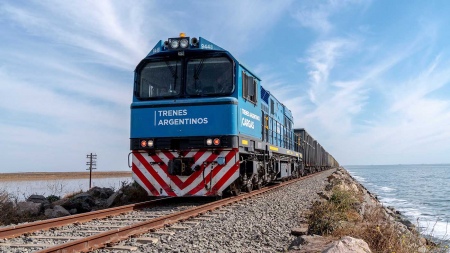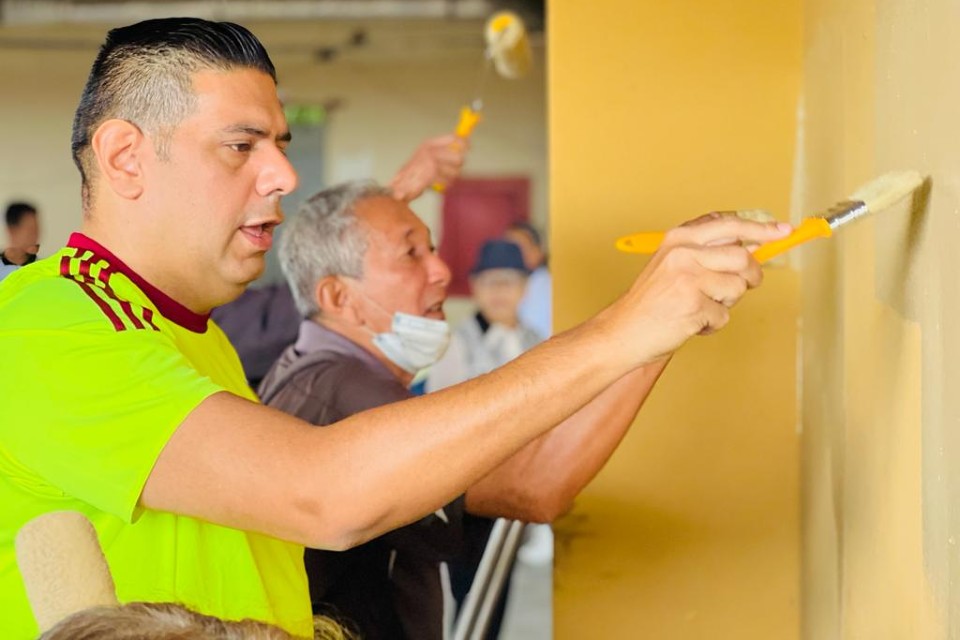The president of Trenes Argentinos Cargas (TAC), Daniel Vispo, affirmed this Friday that “when you invest in the railway, the railway responds, and proof of this is the exponential growth it has had in the last three years.”
“We proposed four management axes that are to repair the largest number of wagons and locomotives, change sleepers and fixings, have a competitive rate and as a consequence of the above transport more tons,” Vispo said in exclusive statements to Télam.
In this sense, he added that “We are working with these objectives and will continue to do so because the results are encouraging for the railway. That is why I say that, if there is investment, the railway responds”he remarked.
??? ???????? ? ?????????
We are close to closing another record year in tons transported. With almost 8⃣ million shipped up to November, we have already grown +60% vs. 2019
??? We work together with the @MindeTransporte to strengthen our railways. pic.twitter.com/es1bZeClNC
– Argentine Trains Cargas (@TACargas) December 7, 2022
Vispo explained that since the management began “36 road works of different scopes have been carried out with private contractors, carrying out a total of 1,150 improved kilometers and 223 rehabilitated sections, in addition to the tasks carried out with the 130 own crews.”
“In this same line, for the first time, preventively, the intervention of the so-called works of art, which are the sewer and bridge work, carrying out in the year 2022 a total of 35 works; The general repair of 19 locomotives that were out of service was completed, two of them were repaired in private workshops and 15 in their own workshops, ”he explained.
He added that “1,005 wagons were intervened in a general way, 302 of them in private workshops and 703 in own workshops, which is added to the purchase of 10 bulk hoppers and 90 containers manufactured in Argentina.”
Continuing with the completed works, he indicated that “a hundred civil works were carried out in different company facilities, such as workshops, service stations, changing rooms, installation of machinery, bathrooms, enclosures, etc., which favor productivity and daily work of the workers and workers”.
“In turn, together with the Ministry of Transport, work was done to promote multimodalism through logistics synergy with other means of transport and the development of regional economies,” he said, adding that “The Ministry has been a mainstay for the development of Trenes Argentinos Cargas, with its contributions and support. Both the management of Mario Meoni, as well as the continuity of Alexis Guerrera and now with Diego Giuliano”.
“Efforts have been made so that more merchandise with added value is transported by train and as a result there was a considerable increase in consumer products that are destined for different provinces of the country”Daniel Vispo
He described that “in March the construction of the Logistics node in Güemes, Salta; project that will expand the area of influence of the railway. The works carried out jointly by the Ministry of Transport, Trenes Argentinos Infraestructura, the Government of Salta and TAC already reached 20% progress in the month of October”.
“At the same time -he said- last July the Logistics node in San Francisco, Córdoba; that within days of being operational received the first 35 containers of alfalfa that were dispatched to the port of Buenos Aires to be exported to the Middle East”.
He pointed out that “work has been done so that more merchandise with added value is transported by train and as a result there was a considerable increase in consumer products such as beverages, cement, beans, cellulose pulp, among others, which are destined for different provinces of the country like Santiago del Estero, Jujuy, Salta, Chaco, Tucumán, San Luis and Mendoza. In addition, many of these traffics have the characteristic of going with loaded round-trip trains, which optimizes costs”.
“As a result of everything that has been done, TAC transported in 2021 and the same will happen in 2022 more than 8 million tons, which represents more than 60% more than what was transported in 2019, another historical record for freight railways.
The national State seeks to regain control of the roads in the hands of private
The State hopes to regain control of the roads throughout the national territory, some of which today remain under the concession of private operators, and in this way “to be able to exercise greater control over maintenance and investments in infrastructure that are made.”
The president of Trenes Argentinos Cargas indicated that “the situation has two channels, one political and the other operational. Of the 32,000 kilometers of roads that existed, today only 16,000 remain, of which 9,100 are in our hands and under our execution, and that is the operational part”.
“The remaining 7,000 are being operated by private companies, and that is the political part, because it requires political decisions for its evolution,” he said.
“Regarding our work -he explained- we have been recovering the infrastructure and seeking a better and more efficient service, and in regards to the concession, we are attentive to the end of them and the steps to follow later, because These concessions cannot continue to be extended further,” he added.
Vispo explained that “the specifications for a new tender have already been drawn up, in which it is expected that 50 percent will be contributed by the State and the remaining 50 percent by the private operator that wins the concession. But what cannot continue to happen is that the private operator has control of the roads and the investments”.
“The State will be in charge of maintaining the tracks and their execution, and the private operator will pay a fee for the use of the infrastructure and rolling stock that will be granted”he clarified.
Vispo estimated that “for next year we will be seeing how all this is coming to fruition, and we will be able to make progress in ensuring that the railway continues to grow as the productive engine of the country.”
A SHARED PASSION ??
?For Mauro, being a railway worker is synonymous with camaraderie and responsibility.
There is no better job than what we do #All together
#We keep growing pic.twitter.com/wKRtctXt0g– Argentine Trains Cargas (@TACargas) December 13, 2022
Trenes Argentinos Cargas (TAC) is a company under the Ministry of Transportation that operates the three freight rail lines: Belgrano line, which runs through the center and north of the country; San Martín line, which crosses the national territory from east to west and the Urquiza line, which borders Mesopotamia.
The extension of the network is 9,100 kilometers that directly impact the productive economy of 16 provinces: CABA, Buenos Aires, Entre Ríos, Corrientes, Misiones, Chaco, Santa Fe, Santiago del Estero, Tucumán, Salta, Jujuy, Chaco, Mendoza, San Juan, San Luis and Catamarca. Its assets consist of a total of 175 locomotives and more than 8,300 wagons.
The charge is made up of agricultural products, aggregates, wood, minerals, consumer products and other eventualand in 2021 a historical record was reached with 8 million tons and TAC consolidated itself as the main railway operator in the country with a 34% market share.
Since the administration began (2020) and in line with the Modernization Plan of the Ministry of Transport, the TAC management team designed a management strategy aimed at improving the company’s operational capacity that crystallized in these main axes to guide management: repair and maintain the road; recover rolling stock and increase the amount of cargo.
Repair of wagons, locomotives and tracks, the axes of management
During the current government administration, special emphasis was placed on the repair of wagons, locomotives and tracks “and this had the objective of improving the conditions of the assets to be able to develop the logistics activity in such a way that it allows transporting the greatest amount of cargo possible at a competitive rate,” said Daniel Vispo.
“The concrete result is that, in the period January-November 2022, TAC transported 7,837,712 tons, which represented 60% more compared to 2019. This growth compared to 2019 is also reflected in each of the lines. The The Belgrano line increased its load by 63%; the San Martín line by 59% and the Urquiza line by 63%,” Vispo explained.
He clarified that, in general terms, “the products that increased their amount of cargo were aggregates (clinker, coal, stone, sand and lime) with more than 84% and those for consumption (wine, water, juices, cement, paste cellulose) with 200%, all compared to 2019. For their part, agricultural products such as soybeans, corn and sunflower are the most transported, representing 56% of the total cargo.”
The head of TAC highlighted that, within the freight railway scheme, Logistics Nodes are “of capital importance”.
“The node boosts regional production by allowing the collection and containerization of merchandise that arrives at ports by rail,” he said.
In another order, he described that “after seven years of being inactive, in September the Urquiza railway resumed international traffic with Paraguay at the Posadas-Encarnación crossing. The agreements between TAC and Ferrocarriles del Paraguay generated new merchandise flows, reducing logistics times and costs, with the possibility that local producers can export value-added merchandise, generating new foreign currency inflows.”
“This action – he said – began in 2020 when the northern section of the line connecting Corrientes with Misiones, which had been closed by an arbitrary decision, was rehabilitated. Being able to make its full route between headwaters (Zárate in Buenos Aires-Garupá in Misiones) allowed that new products are transported by train, and that tons increase from an average of 25,000 per month to more than 45,000”.
He concluded by detailing that “in November and within the framework of the Transportation Modernization Plan the heavy improvement of 15 kilometers of track of the C3 branch, between the towns of Puerto Tirol and Laguna Blanca, was completed; sector that forms part of a more extensive corridor that goes from Avia Terai to the port of Barranqueras; all in Chaco territory”.
“The works included changing the rails, 1,200 sleepers per kilometer with their respective fixings, in addition to the corresponding ballast stone filling and trenching in the area. During the past year, in this section, the gross tons transported grew by 22% compared to 2019”, ended.









